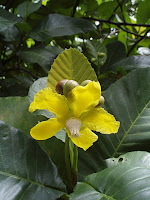We couldn't bear to laze the day away, so off we went to Sungei Buloh Wetland Reserve. This was the kids' favourite haunt several years ago. While they were fascinated with the huge monitor lizards and spiders in the past, they would rather slay virtual demons and monsters these days. It's a good thing C.H. enjoys these nature romps so I always have company.
.
This 130-hectare wetland reserve is home to over 500 species of tropical flora and fauna, as well as a stop-over point for migratory birds. In the past, we've even managed to see a family of otters frolicking in the waters! Unfortunately they didn't make an appearance today.

From the observation hut, we saw a big flock of birds on the mudflats. The most common birds found here are the plovers, sandpipers, egrets and herons.

This mangrove plant, Rhizophora sp., has roots that branch from trunks like stilts. This helps to prop up the tree in the soft mud so that it will not topple with the ebbing and rising tide.

Sungei Buloh Wetlands is very close to Malaysia. Can you see the tall buildings across the the Johor Straits? That is Johor, Malaysia.

We arrived at the aerie - a 18-m tall tower hide which offers a panoramic view of the wetland reserve.


The commonly found Dillenia suffruticosa is a large scrub that can grow up to 7 meters tall. The bright yellow flower open and fall within the same day. The ripe fruit is pink splitting into 7 to 11 radiating segments. Fruit eating birds love the seeds. In the 1970s, the leaves were used to wrap local food like fried noodles.

The pencil-like roots of the Avicennia sp branch upwards from the main horizontal roots that grow below the soil. These roots allow the absorption of atmospheric oxygen through specialized root cells. This adaptation is important, as the mud that the mangrove trees grow is extremely low in oxygen.
Can you spot a big mudskipper in the middle? It is a bizarre fish that can frolick out of water. It has protruding eyes that stick out of the water and enable it to observe it's surrounding as well as modified fins that help propel it out of water and across the mudflats.

The raised wooden mangrove boardwalk allows us to take a close look at the mangroves without getting our feet wet. When the tide rolls in, tree-climbing crabs scuttle up the mangroves to avoid the water.
Beneath the tranquility, Sungei Buloh is really teeming with life. We looked under the leaf to find a cluster of beetles.
We saw a skink sunbathing on an old tree trunk.
After Sungei Buloh Wetland Reserve, we drove to the nearby Bollywood Veggies which is the largest producer of organic bananas and papayas in Singapore. They also specialise in fruit vegetables such as ladies fingers, long beans, cucumbers, bitter gourds as well as uncommon medicinal trees and herbs.













.jpg)
.jpg)
.jpg)
.jpg)




7 comments:
Fantastic and informative pictures!
Wish I could escape into one of them!
What a very cool place!! What great pictures too!!
THANK YOU for the tour, Blur!!! You'd do VERY well if you were a tour guide ha ha ha ha ha...
love the mangrove roots and the beetles ^_^
and the skink too!
Great pictures ... erm..Maybe I should go there one of these days also..
Thanks World. I'm sure you'll enjoy this place too.
Mike - Thanks :-)
Amel - Ha ha, I'll be a volunteer in future. This place needs eco-volunteers actually.
Seagrape - I think you'll find lots of photo opportunities if you go there... knowing how you have an eye for details
Waterlearner - You'll like the place. It gets humid in there and some parts have mozzies too. So be prepared!
Post a Comment